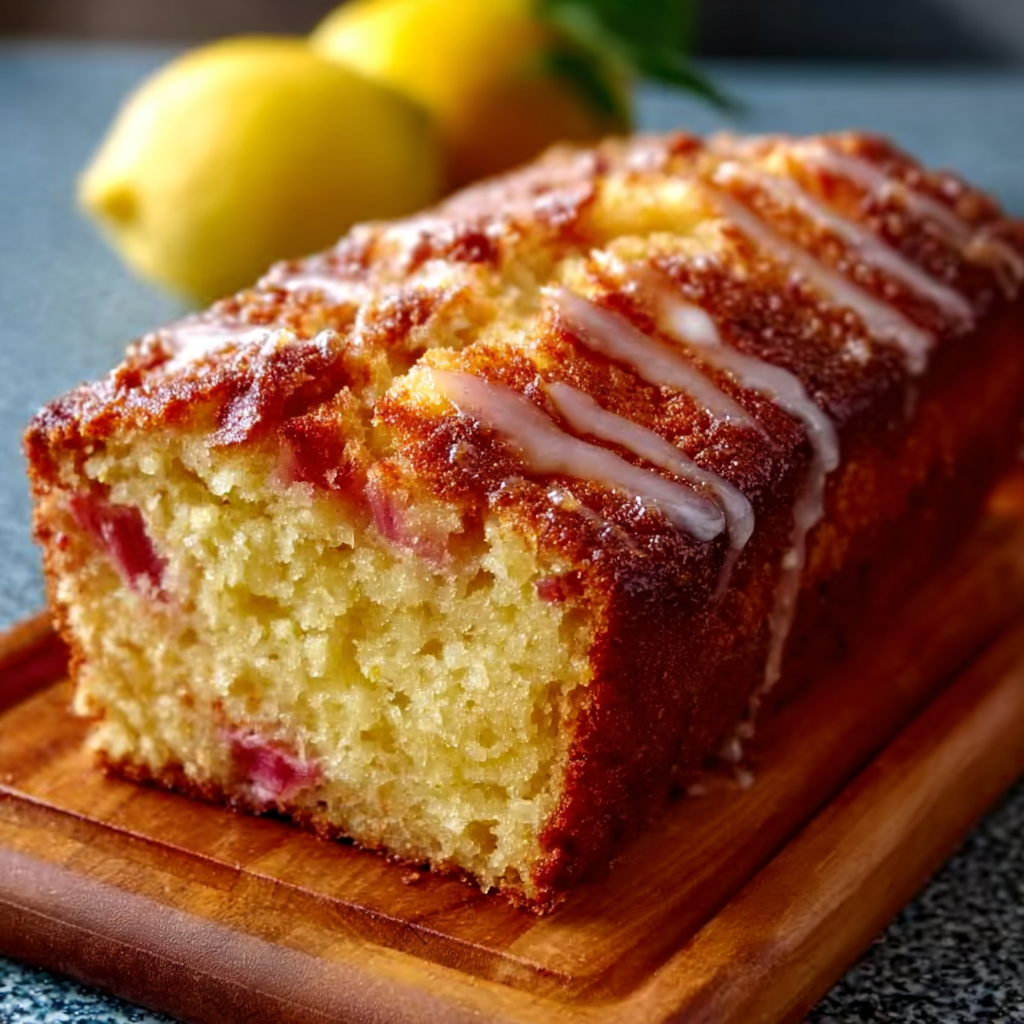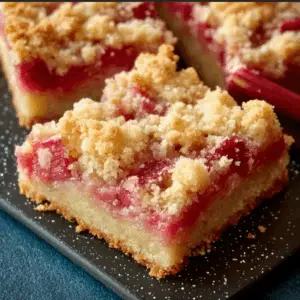Best Lemon Rhubarb Loaf with Glaze – Bright, Tender & Easy
Also known as Lemon Rhubarb Bread or Rhubarb Lemon Loaf, this recipe combines the cozy comfort of a quick bread with the sunny brightness of a lemon cake. Each slice delivers a soft, tender crumb, fresh citrus aroma, and a glossy lemon glaze—making it an easy mix-and-bake rhubarb dessert that feels special any day of the week.
Built on classic quick bread techniques, this loaf highlights the vibrant flavor of fresh rhubarb and zesty lemon, supported by the perfect balance of baking powder and baking soda for a light lift. For more ideas, explore rhubarb desserts for seasonal inspiration.
Its moist, plush texture comes from the combination of oil, tangy sour cream, and fragrant vanilla extract. A final drizzle of citrus glaze adds both flavor and eye-catching shine—browse lemon glaze ideas and quick bread styling tips to plate this loaf beautifully for brunch, tea, or gifting.

Why You’ll Love This Lemon Rhubarb Loaf
-
Fresh, vibrant lemon flavor from real juice and zest
-
Moist, tender crumb thanks to sour cream and oil
-
Made with simple pantry staples for easy prep
-
Glossy lemon glaze that sets perfectly every time
Every slice of this lemon rhubarb loaf is moist, soft, and bursting with bright citrus, making it taste like a bakery-quality quick bread without complicated steps. Tart rhubarb pieces add pops of flavor, while the lemon glaze brings a sweet-tangy finish and a beautiful sheen. Quick to mix and bake, this rhubarb dessert is perfect for brunch trays, edible gifts, afternoon coffee breaks, or weeknight baking.
Ingredient Notes & Easy Substitutions for Lemon Rhubarb Loaf
These tips will help keep your lemon rhubarb loaf ultra-moist, bursting with citrus flavor, and reliably tender. Always measure ingredients by weight for accuracy, keep an eye on acidity levels, and mix gently to preserve the soft, bakery-style crumb.
For structure, follow quick bread basics—baking powder and baking soda work together for an even rise. Fresh lemon juice and zest deliver bold citrus brightness, while sour cream adds rich moisture and vanilla extract enhances aroma. The result is a plush loaf that slices cleanly every time.
Select fresh, vibrant rhubarb stalks for the best flavor and texture, and infuse the batter with zest-first lemon flavor before baking. Finish with a glossy lemon glaze for sweetness and shine—check out lemon glaze ideas for pourable consistency cues, and explore quick bread styling tips for serving inspiration and perfectly clean slices.
All-purpose flour
-
Provides structure; weigh for consistent crumb.
Baking powder + baking soda
-
Dual leavening aids rise and browning.
Fine salt
-
Balances acidity; sharpens lemon character.
Granulated sugar
-
Sweetens, tenderizes, and improves moisture retention.
Lemon zest + fresh lemon juice
-
Zest perfumes; juice brightens and tenderizes.
Neutral oil
-
Keeps loaf moist longer than butter.
Eggs
-
Bind batter; set crumb and color.
Sour cream or Greek yogurt
-
Acidity plus fat = plush, tender crumb.
Vanilla extract
-
Rounds citrus; adds bakery-style aroma.
Rhubarb (diced small; toss with 1 Tbsp flour)
-
Small dice prevents sinking; flour reduces bleed.
Glaze
-
Powdered sugar + lemon juice; pinch salt.
Substitution ideas
-
Buttermilk works; add 1–2 Tbsp flour for
-
Use dairy-free yogurt; keep oil unchanged here
Rhubarb Guide: How to Pick, Prep, and Cut for Lemon Rhubarb Loaf
Selecting the right rhubarb is key to making a lemon rhubarb loaf with a tender crumb, balanced tartness, and juicy pops of flavor in every bite.
How to Choose Rhubarb
Look for firm, crisp stalks with smooth, glossy skin. Avoid limp or woody pieces, as they can be fibrous and less flavorful. For quick identification and cooking uses, see Rhubarb (plant).
Fresh vs. Frozen Rhubarb
Fresh rhubarb gives the cleanest texture, but frozen works well when properly handled. Thaw completely, pat dry, and lightly coat with flour to prevent soggy spots in the batter.
Do You Need to Peel Rhubarb?
Usually no—only peel away tough, stringy outer fibers on very mature stalks to improve texture and avoid long strands in your loaf.
Best Dice Size
Cut rhubarb into small, even pieces about ¼–⅜ inch. This helps distribute tartness evenly, supports the loaf’s rise, and minimizes fruit sinking in quick bread batters.
Seasonality & Color
Peak-season rhubarb in spring is naturally more tender. Red stalks aren’t sweeter than green, but they create beautiful contrast under a shiny lemon glaze.
Safety Tip: Leaves Are Toxic
Never eat rhubarb leaves—they contain oxalic compounds. Always discard leaves, wash stalks well, and keep them away from pets.
How to Maximize Lemon Flavor in Lemon Rhubarb Loaf
Layering citrus flavor is the secret to a bright, fragrant lemon rhubarb loaf that stays balanced from the first bite to the last.
Zest First
Rub fresh lemon zest into the sugar before mixing—this releases aromatic oils and intensifies lemon flavor without adding excess liquid.
Use Fresh Juice
Squeeze lemons just before adding to the batter. The acidity not only boosts flavor but also gently tenderizes the loaf’s crumb.
Balance Tartness and Sweetness
Keep the sugar amount as written to maintain a moist, tender texture. The lemon glaze will add an extra hit of brightness on top.
Layer Flavor Strategically
Incorporate lemon zest into sugar before adding it to the wet ingredients. This ensures even citrus distribution throughout the batter.
Don’t Skip the Salt
A pinch of salt sharpens flavors, tones down any bitterness, and makes the lemon notes pop in every slice
Equipment & Pan Preparation for Lemon Rhubarb Loaf
Having the right tools and prepping your pan properly will make baking a lemon rhubarb loaf smooth, mess-free, and easy to slice.
Essential Tools
-
9×5-inch metal loaf pan lined with a parchment paper sling for easy lifting and sharp, clean edges
-
Digital kitchen scale for precise ingredient measurements
-
Microplane zester for fine, aromatic lemon zest
-
Mixing bowls, whisk, and spatula for accurate mixing and gentle folding
-
Oven thermometer to ensure your oven stays at 350°F (175°C)
-
Cooling rack for even airflow as the loaf sets
Pan Prep
Lightly grease the loaf pan, line it with parchment paper (allowing overhang for a sling), and grease again for a completely stick-free release.
Pro Tip
Bring eggs and dairy to room temperature before mixing—this helps the batter combine smoothly and rise evenly.
Step-by-Step: Make the Batter
Preheat the oven to 350°F and position a rack in the center. Grease a 9×5-inch pan, line with a parchment sling, and set aside.
Whisk flour, baking powder, baking soda, and fine salt until evenly combined.
In a large bowl, massage lemon zest into sugar until fragrant and slightly damp; this releases oils for vivid lemon flavor.
Whisk in neutral oil, eggs, sour cream or Greek yogurt, fresh lemon juice, and vanilla until smooth and glossy.
Add dry ingredients to wet and stir gently with a spatula just until a few streaks remain; avoid overmixing to keep the crumb tender.
Dice rhubarb small and toss with one tablespoon flour to reduce bleeding and sinking.
Fold rhubarb into the batter with broad, gentle strokes, scraping the bowl and rotating to distribute evenly without deflating.
Scrape batter into the prepared pan, smooth the top, and tap once on the counter to release air bubbles.
Bake until domed and golden, 50–60 minutes; rotate if the oven runs hot on one side. Tent loosely with foil during last 10–15 minutes if browning too quickly.
Cool in the pan for 15 minutes; lift onto a rack and cool completely.
For the lemon glaze, whisk powdered sugar with fresh lemon juice, fine zest, and a pinch of salt until smooth and pourable.
Adjust consistency with more sugar to thicken or more juice to loosen, then drizzle over the cooled loaf and let it set before slicing.

Bake, Cool & Glaze
Slide the filled pan into a 350°F oven and bake until the loaf is domed, deeply golden, and set through the center. Visual cues help: a split ridge along the top, edges pulling slightly from the pan, and a gentle spring back when pressed. A skewer inserted in the center should emerge clean or with a few moist crumbs.
If the top colors too fast, tent loosely with foil for the final minutes so the interior can finish without overbrowning. Ovens vary, so begin checking at fifty minutes and continue in short intervals.
Cool the loaf in the pan for fifteen minutes to allow structure to set, then lift out using the parchment sling and cool completely on a rack.
Whisk the lemon glaze until pourable, then drizzle over the fully cooled loaf for a shiny finish that sets beautifully. Adjust with a teaspoon of juice to loosen or a tablespoon of sugar to thicken, aiming for steady ribbons that slowly disappear back into the bowl. Let the glaze set before slicing to keep edges tidy and clean for serving.
Doneness Cues & Timing by Pan
Timing shifts with pan size and material, so watch the loaf, not the clock.
-
9×5-inch metal loaf: typically 50–60 minutes at 350°F; start checking at 48 minutes.
-
8½×4½-inch pan: slightly taller loaf; often needs 5 extra minutes for the center to set.
-
Mini loaves: begin checking at 22 minutes; expect 22–30 depending on thickness.
-
Muffins: 18–22 minutes; rotate the pan once for even color.
-
Ready when tops are domed with a central crack, spring back gently, and a skewer returns clean or with moist crumbs.
-
Glass pans often brown slower; extend bake slightly and verify doneness carefully near the center.
Pro Tips & Common Mistakes
Small tweaks protect a plush, tender crumb and vivid citrus.
-
Weigh ingredients for consistency; volumetric cups can swing moisture and texture.
-
Keep batter slightly thick so rhubarb stays suspended instead of sinking.
-
Rub zest into sugar to amplify lemon oils without diluting the batter.
-
Mix gently after adding flour; overmixing develops gluten and toughens the loaf.
-
Dry thawed rhubarb thoroughly; excess water causes gummy streaks and pale sides.
-
Don’t cut sugar drastically; it affects browning, moisture, and softness.
-
Tent with foil if browning fast; avoid burning edges while the center finishes.
-
Let the loaf cool completely before glazing and slicing to avoid collapse.
-
Use a sharp, serrated knife for tidy slices; wipe between cuts.
-
For high altitude, increase oven temperature 15°F and add a tablespoon extra flour.
-
Warm chilled slices briefly to refresh crumb; room temperature tastes brighter and softer.
-
Avoid dark glass pans; metal conducts better, promoting rise, color, and clean edges.
-
Keep batter cold for neater domes tops.
Variations & Add-Ins
-
Strawberry-Rhubarb Lemon Loaf: Replace half the rhubarb with equal diced strawberries; reduce juice one teaspoon if berries are very juicy.
-
Lemon Poppy Seed Rhubarb Loaf: Add one to one and one-half tablespoons poppy seeds; sprinkle a few on top before baking.
-
Almond-Lemon Rhubarb: Add a quarter teaspoon almond extract; scatter sliced almonds on the loaf for crunch and aroma.
-
Crumb-Topped Version: Mix flour, sugar, cold butter, and a pinch of salt; crumble over batter and bake slightly longer.
-
Orange-Rhubarb Twist: Swap in orange zest and juice for a softer, floral citrus; keep sugar unchanged.
-
Gluten-Free: Use a cup-for-cup gluten-free blend, add one tablespoon additional moisture, and rest batter five minutes before baking.
-
Dairy-Free: Use unsweetened plant yogurt; confirm neutral oil, and ensure glaze contains only powdered sugar, citrus, and salt.
-
Coconut-Lemon: Replace two tablespoons oil with melted coconut oil; finish with toasted coconut on the glaze.
-
Lemon Syrup Soak: Brush warm loaf with simple lemon syrup for extra moisture and tang before glazing.
-
Adjust bake time slightly to suit additions.
Storage, Freezing & Make-Ahead
Keep this lemon rhubarb loaf soft by storing it properly from day one.
-
Room temperature: Wrap tightly or store in an airtight container up to two days.
-
Refrigerate: Keep up to five days; bring slices to room temperature or warm briefly.
-
Freeze whole: Wrap in plastic, then foil; freeze up to three months.
-
Freeze slices: Separate with parchment and store airtight for easy snacking.
-
Thawing: Unwrap and thaw on a rack to prevent condensation from sogging the crust.
-
Make-ahead: Bake and cool completely, freeze unglazed, then thaw and add the lemon glaze right before serving for best sheen.
-
Avoid the fridge for uncut loaves when possible; wrapped at room temperature keeps crumb softer and the glaze glossy after full cooling.
Serving Ideas
Slice thick or thin and pair with coffee or tea for a cozy treat.
-
Add a dollop of yogurt or crème fraîche and extra zest.
-
Serve with macerated berries.
-
Dust with powdered sugar.
-
For brunch, plate warm slices with softly whipped cream.
-
Finish with lemon glaze ribbons and zest curls.
Nutrition Snapshot
This lemon rhubarb loaf is a treat, not health food, balancing sugar and fat for a plush texture. Slice thinner, savor slowly, and pair with protein like yogurt or eggs to keep breakfast satisfying while enjoying bright lemon flavor daily.

Rhubarb Cake & Bread FAQs
Can I use frozen rhubarb in this recipe?
Yes—thaw it completely, pat it dry, toss with a little flour, and bake for a few extra minutes if needed.
Do I need to peel rhubarb before baking?
Usually not. Only peel older, fibrous stalks to prevent stringy texture.
How can I stop rhubarb from sinking to the bottom?
Dice it into small pieces, coat in flour, and keep the batter thick. Avoid overmixing.
Can I make this without sour cream?
Yes—swap with Greek yogurt, or use buttermilk plus 1–2 extra tablespoons of flour to maintain structure.
Can I reduce the sugar in the recipe?
A small cutback is fine, but reducing too much will affect moisture, tenderness, and browning.
Can I bake this recipe as muffins?
Yes—divide the batter into muffin tins and bake for 18–22 minutes, checking early for doneness.
Is rhubarb safe to eat?
The stalks are edible, but the leaves are toxic. Discard all leaves immediately.
Why is my loaf gummy in the middle?
It may be underbaked or have too much moisture. Dice rhubarb smaller and allow the loaf to cool fully before slicing.
Can I skip the glaze?
Absolutely—try a dusting of powdered sugar or a light lemon syrup soak instead.
How should I store rhubarb cake or bread?
Keep at room temperature for up to 2 days, refrigerate for up to 5 days, or freeze for up to 3 months.
Lemon Rhubarb Loaf With Glaze The Best Rhubarb Loaf Recipe
This lemon rhubarb loaf bakes up soft and plush, with bright fresh lemon juice and zest running through every crumb. Tart rhubarb bits sparkle against a buttery-citrus backdrop, and a glossy lemon glaze seals in moisture for a bakery-style finish that slices cleanly.
It’s the sweet spot between cozy quick bread and sunny lemon loaf: easy to whisk together, reliable rise, and that gently tender crumb everyone asks for. Perfect for brunch, gifting, or an anytime rhubarb dessert that tastes as cheerful as it looks.
- Author: Clara
Ingredients
- 1½ cups (190 g) all-purpose flour
- 1 tsp baking powder
- ½ tsp baking soda
- ½ tsp fine salt
- ¾ cup (150 g) granulated sugar
- Zest of 1 large lemon
- ½ cup (120 ml) neutral oil (canola or light olive)
- 2 large eggs, room temperature
- ½ cup (120 g) sour cream or plain Greek yogurt
- 2 tbsp fresh lemon juice
- 1 tsp vanilla extract
- 1½ cups (180–200 g) rhubarb, diced small (toss with 1 tbsp flour)
Lemon Glaze
- 1 cup (120 g) powdered sugar, sifted
- 2–3 tbsp fresh lemon juice (to desired thickness)
- 1 tsp finely grated lemon zest
- Pinch of salt
Instructions
Preheat the oven to 350°F (175°C). Grease and line a 9×5-inch loaf pan with parchment, leaving overhang for easy lifting.
Whisk the flour, baking powder, baking soda, and salt in a bowl. In a separate large bowl, rub the sugar and lemon zest together with your fingertips until fragrant, then whisk in the oil, eggs, sour cream, lemon juice, and vanilla until smooth.
Add the dry ingredients to the wet and stir just until a few streaks remain. Toss the diced rhubarb with 1 tablespoon flour, then fold it gently into the batter until evenly distributed.
Scrape the batter into the prepared pan and smooth the top. Tap the pan once on the counter to release air bubbles.
Bake until the loaf is golden and a skewer inserted in the center comes out clean or with a few moist crumbs, 50–60 minutes. If browning too quickly, tent loosely with foil for the last 10–15 minutes.
Cool in the pan for 15 minutes, then lift out to a rack to cool completely.
For the glaze, whisk the powdered sugar, lemon juice, zest, and a pinch of salt until smooth and pourable. Adjust with more sugar or juice as needed. Drizzle over the cooled loaf and let set before slicing.
Store covered at room temperature up to 2 days or refrigerate up to 5 days. For best texture, bring chilled slices to room temp or warm briefly before serving.
Notes
-
Dice rhubarb small (¼–⅜ inch) and toss with a little flour so it stays suspended instead of sinking.
-
Rub lemon zest into sugar before mixing; it blooms citrus oils for deeper flavor without extra liquid.
-
Use fresh lemon juice—bottled can taste flat and dull the loaf’s brightness.
-
Keep batter slightly thick and fold gently after adding flour to protect a tender crumb.
-
Check doneness with a skewer (or ~200–205°F center on an instant-read thermometer); tent with foil if browning early.
-
Cool fully before glazing; drizzle when the loaf is cool so the lemon glaze sets shiny, not runny.
-
Metal 9×5-inch pans brown and rise best; glass often needs a few extra minutes.
-
For muffins: portion into tins and bake about 18–22 minutes; start checking early.
-
Storage: wrap at room temperature up to 2 days; refrigerate up to 5; freeze slices up to 3 months (thaw unwrapped on a rack).
-
Variations: poppy seeds, almond extract, or a light lemon-syrup soak under the glaze for extra tang.




